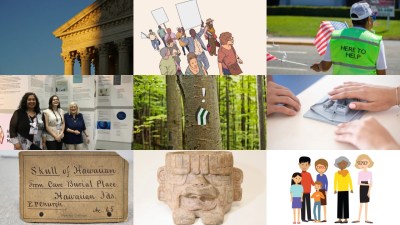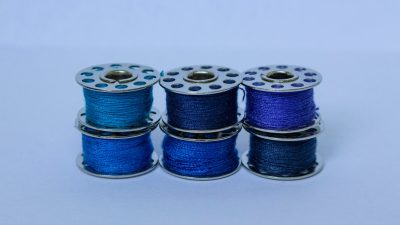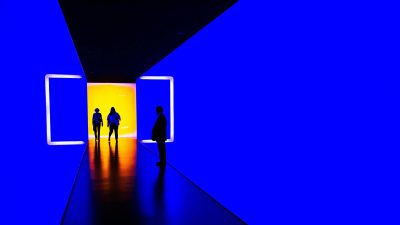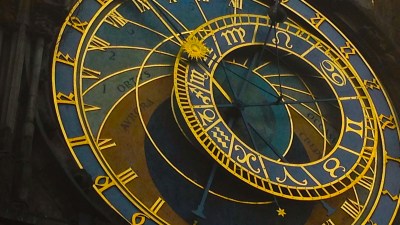
This article originally appeared in the September/October 2016 issue of Museum magazine.
Albert Camus once said, “Fiction is the lie through which we tell the truth.” Good futurist fiction tells the truth about something that hasn’t happened…but could. To explore the potential futures of education—futures in which museums play a starring role—the Alliance’s Center for the Future of Museums recently ran a Future Fiction Challenge. In this issue of Museum, I am happy to share the winner of the challenge’s grand prize. “Standardized” by Keely Sarr, assistant museum educator at the Mead Art Museum in Amherst, Massachusetts, introduces us to a high school in the year 2040, where graduation hinges on the design and installation of a museum exhibition.
In practice, the installation of my senior Test Exhibition involved three main steps: painting, label-writing, and falling in love.
Of course, I would meet a gorgeous, genius girl in Deep Storage rather than holographically or at a soundbar; it’s not like I have time to go out anymore. I only wished I’d known about it in advance, somehow, and could’ve micro sanitized that lingering smell of paint from the back of my neck first. When my mom was a kid, she assumed that her kids would grow up with commercialized, normalized time travel, and then everyone could go back and chill with Ashurbanipal or whatever (at least, that’s what I would do). Too bad the future’s not quite here yet. If I could’ve reversed time by even five minutes that day, I would have annotated the schedule in my monitor with a few helpful hints:
9 a.m.: First bell; arrive in Test Gallery (but you’d better wear a nice dress and not a plain painting jumpsuit: just trust me on this one!)
9:15 a.m.: Turn on paint-bots for wall undercoat (which you really should have done two weeks ago, but you were too busy nerding out over which hex colors to choose)
9:30 a.m.: Head down into storage (where you’ll meet the universe’s most amazing girl, just casually, and wonder where she’s been hiding for the sixteen long years you’ve been alive)
To be honest, though, I was looking pretty styln’ for a girl three months into her Test. My Test Gallery neighbor was this insipid retro-bro with music tastes and misogyny straight out of 2022—who for sure hadn’t done anything vaguely hygienic since February. His Exhibition was some kind of sound installation situation. I predicted that the vibrations from his wall-sized speakers would probably bring down the whole museum before graduation.
Usually, that guy was the only person I saw on my way to Storage; he was down there almost every day, sorting through old synths from the 1970s. When I stepped through my automatic door and locked my Test Gallery behind me that morning, though, all I could see were rows of doors, sealing off the academic prisons in which all of my classmates were busy trying to graduate. (Or sleeping, or lying on the floor eating edamame and staring into the void. You know.) On my way out, I treated myself to a moment at the window, gazing at the tech boutiques lining the street outside my school: solar panels gleaming under the streetlights of the early morning. Smaller, more modern buildings worshipped our great temple of the Lai-Brighton Museum and Academy. Most people could only visit the museum on the weekends, while we luckier kids spent our lives there, participating in Experimental and Experiential Learning Processes (according to our mission statement).
The halls were awkwardly, ordinarily quiet, thanks to the sound-sealing that allowed all of us to experiment with our Exhibitions in secret. Just six months ago, the Galleries were cacophonous classrooms into which my friends and I would stampede on the hour, running from Bioethics to Interpretation to reserve a good seat near the front—because everyone wants to be up close when the objects come out. That’s the Lai-Brighton thing, see. Our half school, half-museum deal was the brainchild of its art collector founders, and now every class is taught by works of art and TA’d by humans, basically. The region’s brightest five-year-olds prep and test and study and pray for one of L-B’s limited youth-long enrollment offers. If they receive one, they are rewarded with twelve years spent alongside delicate watercolor paintings, early manuscripts, watches snatched from the wrists of the anonymous dead, and all the other objects that share their stories to show us the world.
Until the twelfth year, that is. Then it’s time for the Test.
I stepped into the Deep Storage transport and closed my eyes, reminding myself that in the whole history of accelerated elevator technology, only, like, three people had ever died. Still, I had to check my monitor to soothe my breathing pace and heart rate into a safe range by the time I disembarked.
Immediately, I was overwhelmed by Deep Storage’s competing works of art: a Han Dynasty sculpture, a rococo portrait of a guy looking pretty proud of going grey, and, nearby, a girl, her short, dark hair streaked with the palest pink and metallic blue. “Have you seen any paintings of kids around here?” she said by way of greeting. “I’ll even take some weird-looking babies.”
“You’re welcome to take my little brother, if that’d help,” I replied. “But your Gallery wouldn’t last long with him on view.”
The girl smiled, showing off her teeth’s on-trend neon glow. She had to be Testing to be down in Storage, but I had never seen her before. I would have remembered those angular bangs, the three miniature ponytails tufting up from her hair, and that tattoo of a fleur-de-lis near her eyelid.
“I’m Riella. Hoping to finish up installing today.”
“I’m jealous. But you can call me Leimomi,” I replied. “I’ve barely finished painting.”
I wasn’t quite sure why I felt so compelled to tell the truth. I should have lied and said that my genre defying exhibition was 99 percent done and that my bots and I just needed to generate some final schematics.
Truth was, though, I was worried that I would fail my Exhibition.
Back in December, we turned in our last augmented reality projects and spent our final moments virtually reconstructing damaged Maya stelae (in my case, anyway). Like all seniors since the founding of L-B, my class went on winter vacation while our school was transformed into a galaxy of galleries for us to reimagine. To graduate, you have to pass a Test: one that takes six months, thousands of dollars in grant money, and an entire army of helpful paint-bots to complete. Each of us gets an empty gallery, unlimited access to the museum’s storage facilities, and a single essay question: What have you learned?
Of course, it’s not that simple. Teens can’t jump straight from blank walls to an entire visual representation of their accumulated knowledge without a little support, apparently. We created exhibition plans, gallery mock-ups, curatorial statements. I spent countless nights hovering over a design tablet the size of a desk, inputting digital floorplans and spatial mappings of my Test Gallery, determining how best to capture the inner workings of my mind through display cases and framed objects and wall text.
Eventually, I proposed that I would paint each wall (and the ceiling and the floor) a different color and populate each surface with a mosaic of damaged ancient art pieces: relief fragments, alabaster severed heads and hands, tiny pieces of sculptures too broken to put back together. Because the paint on these now-plain works had long deteriorated, I would juxtapose them against a colorful backdrop. Or something.
Anyway, I started telling Riella about my idea, shyly, mostly ashamed. “I mean, I love ancient art, I seriously do,” I said, finding it very easy to say the word love while staring at her. “I knew I wanted to study it as soon as I first visited Reconstructed Babylon, like, in eighth grade. But I just don’t know how to share it with the Proctors.”
Riella’s lips are a dark cranberry color—the kind of hue I could only ever get through a collagen adjustment— and she chewed on them a little as I spoke. What are you trying to say, Lei?”
“I mean—I guess that I have no idea what I’m doing…”
“No,” she interjected. “What are you trying to say with your Gallery? What’s the message?”
“Um, I like old stuff, and also: let me graduate?”
I was rewarded with a laugh, and then, suddenly, a hand on my arm, leading me back to the transport.
“Want to see mine?” Riella asked.
Like all of the Test Galleries, Riella’s was guarded by a thick metal door, equipped with a retinal scanner that we’re pretty sure is mostly for show. She blinked once at the screen, and we entered a universe of circles.
The walls were painted #f9f8f4, just a step from white, and graced with endless grids of ovals, clusters of circular frames on every inch of wall space. Inside each oval was a different face—pale daguerreotypes and reliefs in profile, scribbled self-portraits and wide-eyed cherubs, preserved princesses shining in layers of lace and silk, abstract faces formed from fractals and lines. There were even modern kids on screens with spectral hair extensions or silver contacts, their nostrils flaring again and again as the holograms replayed one brief moment of breath.
“I’m a transfer student,” said Riella, which—to be honest—was kind of the last thing I expected her to say. I watched her lean backward, her head just covering the face of a young noble from 15th-century France. “I only got the scholarship to L-B for my senior year. My parents sold their house and bought a studio here so I could go.”
No wonder I didn’t recognize her.
“Do you know what normal schools do instead of Gallery Tests?” she asked. I knew that other schools existed, of course—big ones with thousands of kids processed from early childhood to employment by age eighteen—but I’d been at L-B since the beginning. For me, education was one big journey into the past, illuminated by objects and labels. As close to time travel as you could get.
“Tests are all we ever did,” Riella said. “They’re super old—like, great-grandma-style. We get together in cramped little computer-booths and answer questions to determine our basic competence and employability. How well you can add? How well you can parse new words? The world inside a little fill-in-the-blank bubble.”
“So your Exhibition is a statement,” I said. “You’re getting political.”
Riella shrugged. “It’s less of a statement and more— just having something to say. Tell me, Leimomi,” she said. “If someone came up to you and asked you why they should visit the L-B with everything else going on in the world, what would you say?”
My mind uncovered a cache of words like adventure and escape and feeling like you understand your context in the universe, but before I could speak, she just pointed at me.
“Don’t say it. Tell me by putting it in your Test Gallery.”
Before I knew it, I was back in the hall, and Riella was waving goodbye. I took a deep breath.
“Hey, Riella? When I figure it out—what I want to say—want to meet up and chat about it sometime?”
She smiled and pushed her perfectly pastel hair behind her ears.
“For sure.”
I returned to my Test Gallery, back among the ruins: the empty hands of lost gods and the broken, pale handles of raised goblets long forgotten. I leaned back against a bare wall and synced a new itinerary into my monitor, setting the date for June 16, 2040. Graduation.
9 a.m.: First bell; make all final adjustments to wall text (and make sure that Cycladic figure without legs hasn’t fallen over again)
9:15 a.m.: Listen for the Proctors’ arrival announcement (and imagine the more important crowds who will come after them someday)
9:30 a.m.: Give a tour of my exhibition (and maybe someday, I’ll share it with kids from all regions: they’ll see me smiling, asking them what they think, knowing that maybe Riella’s doing the same thing somewhere, and that together, we’re sending people through time and drawing them closer—the best type of curation there is).
Keely Sarr is the assistant museum educator at the Mead Art Museum in Amherst, MA








Comments